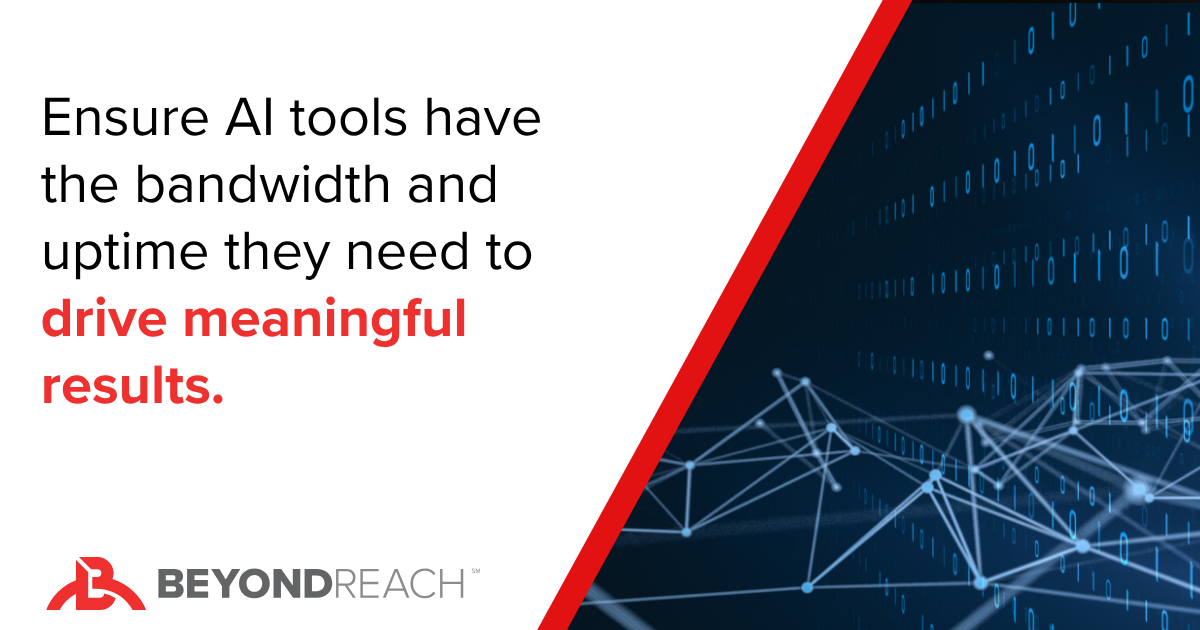Artificial Intelligence (AI) is transforming how today’s industries operate. From real-time decision-making to predictive modeling and automation, AI helps businesses work smarter, faster, and more efficiently. Many organizations tend to overlook the infrastructure required to support AI workloads, which places immense pressure on traditional networks. To keep up, businesses need connectivity that’s redundant, scalable, and purpose-built for high-performance AI applications.
Here’s what that looks like and how BeyondReach builds the infrastructure to support it.
Multiple Circuits: Keep Data Flowing Under Pressure
What It Is:
Multiple internet circuits distribute traffic, reduce latency, and help manage surges in data usage, especially in multi-site or high-demand environments.
Where It Matters:
In distribution and logistics, AI helps plan and adjust shipment loads based on real-time demand. These systems constantly analyze data from multiple sources, including supply chain software and Transportation Management Systems. With multiple circuits in place, operations stay responsive, even during high-traffic periods, ensuring optimal load balancing and fewer disruptions.
Redundant Connections: Eliminate Downtime Risks
What It Is:
Redundancy involves using backup connections, such as fiber paired with wireless, to maintain internet uptime during outages or equipment failures.
Where It Matters:
For renewable energy providers, AI supports smart grid operations by forecasting energy use, detecting faults, and rerouting electricity in real time. Even a short outage can affect public service and grid reliability. Redundant connectivity keeps these critical systems online, allowing AI tools to function without interruption, even during unexpected network issues.
Multi-Line Fiber: Deliver Speed and Failover
What It Is:
Multi-line fiber networks offer high-speed data transmission with automatic failover, ensuring maximum throughput and minimal latency for demanding applications.
Where It Matters:
In manufacturing, AI tools analyze ERP data to determine how best to use on-hand scrap materials. These calculations depend on real-time access to large datasets. Multi-line fiber ensures rapid, uninterrupted communication between AI systems and core infrastructure, allowing production to move forward without delays or data bottlenecks.
Local Towers or Backup Providers: Enable Remote Operations
What Is It:
In remote or infrastructure-poor regions, custom-built towers or partnerships with local ISPs provide reliable, high-bandwidth connectivity where traditional networks fall short.
Where It Matters:
In oil and gas, AI analyzes geological data to pinpoint drilling locations and optimize extraction plans. These operations often take place in remote environments with limited internet access. Establishing local connectivity, through custom-built towers or partnerships with regional ISPs, helps keep AI models online and ensures mission-critical decisions are based on real-time data.
AI Success Starts with Smarter Networks
These examples make one thing clear: AI can only perform as well as the network that supports it. From streamlining logistics to managing energy distribution, AI applications demand fast, reliable, and always-available connectivity. In places where traditional providers fall short, BeyondReach delivers, building tailored infrastructure that ensures your AI tools have the bandwidth and uptime they need to drive meaningful results.
Ready to strengthen your network for AI-driven success? Contact BeyondReach to explore connectivity solutions built for the most demanding digital applications.










